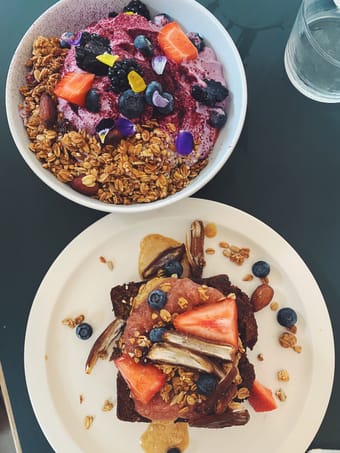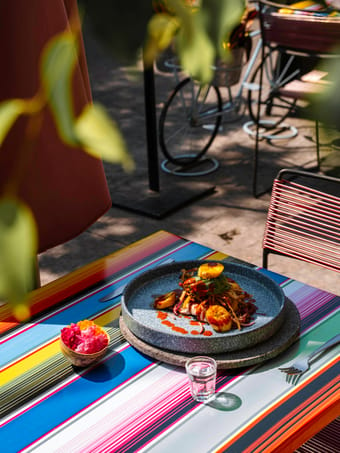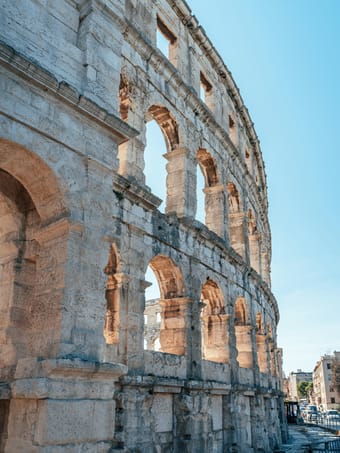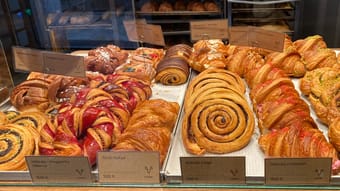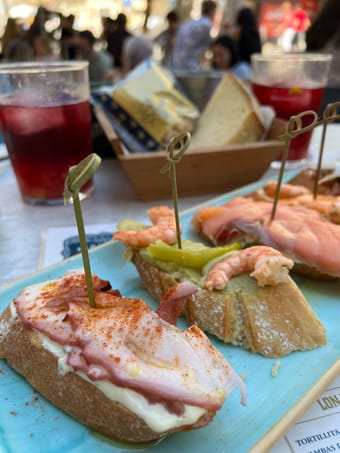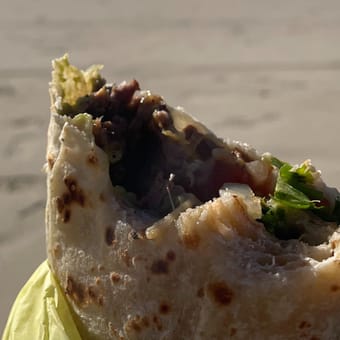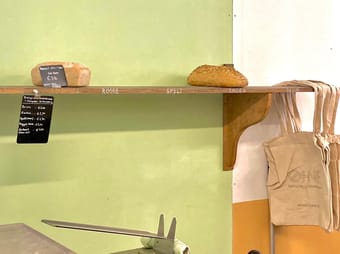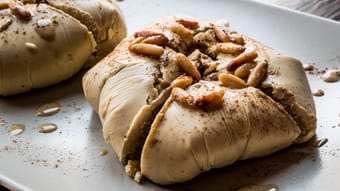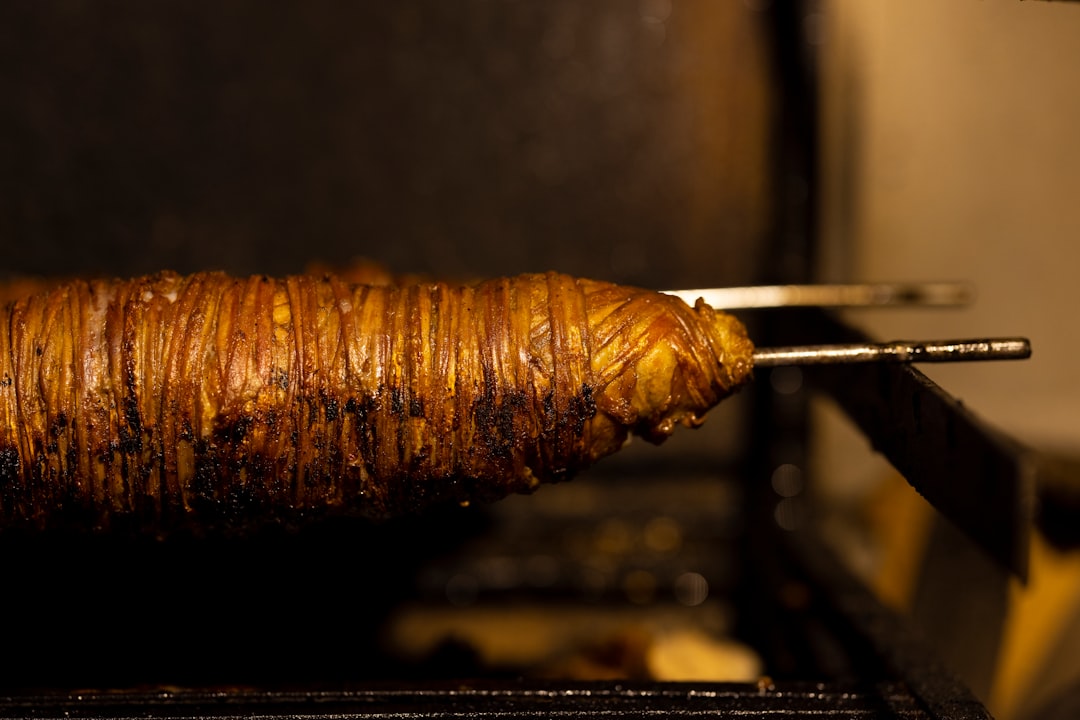Results for Hungary
Are you hungry? Want to get some amazing eats? Here are my top 5 restaurant recommendations in my favorite part of Minneapolis, Northeast (NE). My family grew up in this part of the city and I taught for 8 years at a local school, so this neighborhood holds a special place in my heart.
50+ • Accessibility • Backpacker • Business • Car-free • Couples • Digital Nomads • Family • LGBTQ+ • Pets • Plus Size • Female Solo • Vegan • Vegetarian • Adventure • Art • Budget • Coffee • Design • Foodie • History • People & Culture • Photography • Slow Travel • Wellness • Wine
Free
0
In the past decade, the Copenhagen food scene has really exploded. From the high-end food scene, to the cozy cafés selling the local BMO (scroll to find out what it is!) - you definitely won't leave this city hungry. But you'll probably be a little bit broke.
In this guide, I've saved all my favorite places (plus in the bottom, I added if they have additional locations/branches) - and I'll also continuously add any new spots that I try.
Vegetarian • Groups • Couples • Backpacker • Family • Female Solo • Plus Size • 50+ • Business • Car-free • Vegan • Gluten-free / Celiac • Digital Nomads • LGBTQ+ • Halal • Foodie • Boutique • Luxury • Budget • Wine • Shopping • Romantic • Coffee • Design • Architecture • People & Culture
Free
18
Craving an escape that tantalizes your taste buds and feeds your sense of adventure? Dive into this insider's guide to Todos Santos, a Baja Sur gem where every corner promises culinary delights and hidden wonders. From art-filled streets to pristine beaches, I'll unveil the town's magic, guide you to the hottest eats (my top 5 picks!), and show you unforgettable experiences that will leave you hungry for more (in the best way possible).
Vegetarian • Couples • Groups • Boutique • Budget • Luxury • Outdoors • Relaxation • Wellness • Road Trip • Shopping • Sustainable/Eco • Foodie • Coffee • Adventure • Romantic
$6.00
$10.00
40% off
2
If you're in Paris, hungry and don't feel like spending a salary on lunch out, you've come to the right place! Discover the best food and street food markets in Paris in this detailed guide.
From mouth-watering sandwiches to world cuisine and century-old pâtisseries, you're in for a surprise!
What's in?
🍽️ 6 Markets, Food Markets, & Food Court
⭐ Ideas of things to do near each place
📍 Location + Nearest Metro Stops
💡 Pro tips & Suggestions
Vegan • Vegetarian • Female Solo • Family • 50+ • Couples • Halal • Foodie
Free
10
Everything you need to know to make a perfect circle around Istria, Croatia in 5 days.
Traveling around this pristine peninsula shaped by Roman, Venetian, and Austro-Hungarian influences, you NEED a guide. Touristy "Blue Istria" (the coastal part) and untouched "Green Istria (inside of the peninsula) have both their secrets. You need a friend who's seen it all, and who knows tricks to show you the way. I have been that friend many times, and I want to support you in your exploration too.
Let this be your guide around Istria. I have spent years exploring every part of Istria and I won't stop. Do you know why? Because it is still full of secrets, which can be uncovered with the next visit. I'm putting my best recommendations, and experience into this 5 days itinerary.
What's Included:
📝 5-day itinerary to guide you through Istria (day-by-day activities to uncover Istrian secrets)
🤩 Top things to do and see (they will help you to fill your days)
🍴 Places to eat (recommendations where to taste the best Istrian cuisine)
🛏 Acoomodations to rest after busy days
🍷 Where to taste the best glasses of Istrian wines
Of course, you can prepare an itinerary like that by yourself. But you will still worry yourself if you miss some hidden Istrian secret. Or you can download this guide and instantly feel confident that you'll be able to see and do everything you want.
50+ • Couples • Digital Nomads • Family • Groups • Pets • Accessibility • Adventure • Architecture • Art • Foodie • History • Outdoors • People & Culture • Romantic • Slow Travel • Wine
$5.00
3
Taking a trip to Shanghai? Shanghai is a huge city of over 24 million people so it can be daunting finding somewhere to eat as a vegan/vegetarian. I've taken that burden off your hands and selected my personal favourites and recommendations from friends.
While living in Shanghai from 2017 to 2021, I transitioned to Veganism. Everyone at home thought it would be impossible for me to be vegan or vegetarian in China but real Chinese food is very veggie forward and I was there during a boom in the plant-based food industry which made my life much easier.
So if you're making a trip to Shanghai, here's a list of my favourite Vegan and vegetarian friendly restaurants in the centre of the city and some further out. There are endless options in Shanghai, as one of the largest cities in the world, you'll never be bored or hungry.
*DISCLAIMER* Navigating China on Google Maps is very challenging as Google is not accessible in China so I recommend downloading Baidu maps. Apple maps works but is not 100% reliable with Chinese addresses. Most of the restaurants will be easy to find as they are properly labelled and registered on the map however some of the restaurants in this list are labelled differently to the real restaurant name so please READ the descriptions.
Vegan • Vegetarian • Sustainable/Eco • Budget • Foodie • Romantic • People & Culture
$5.00
1
Have you a sweet tooth?
Do you want to discover the most enchanting and delicious pastry (or bakery) shops in Budapest?
I firmly believe this guide is for you, my dear.
Here is a short but irresistible guide that will take you to the sweet heart of the Hungarian capital, between tradition and innovation.
Couples • Digital Nomads • Female Solo • Groups • Car-free • 50+ • Accessibility • Pets • Plus Size • LGBTQ+ • Family • Backpacker • Foodie • People & Culture • Slow Travel • Coffee • Boutique • Design
Free
0
It has been a lovely sunny month in Málaga (Andalusia), Spain. As I am a real "foodie", the first thing that I checked upon arrival and marked on the map were all the types of restaurants I wanted to visit.
Later on, I tasted multiple ones as well as discussed the options with locals, and here the "price-friendly" list comes.
👇Below you can find our top picks, where we literally almost cried out of the "foodgasm" 😍 Moreover, I will introduce you to "must-try" dishes,
Do not read when you are hungry!🤤
📌Save this guide to your bucketlist!
🎶And stay tunned for more itineraries to come!
You can find my on Instagram: @hungrytraveler_barb
Backpacker • Couples • Groups • Digital Nomads • Accessibility • 50+ • Car-free • Business • Family • Female Solo • Vegetarian • Foodie • Coffee • Wine
Free
3
A self-guided exploration of Florence's foods through the charming neighborhood of Oltrarno, in 5 stops: a pastry shop, a bakery, a market and/or aperitivo, lunch, and gelato.
In addition to each stop's details, this guide also includes information about Oltrarno, recommended foods to try, a quick guide to Italian coffee, what is "aperitivo", and historical information about Florence's famous wine windows.
Visit every stop, or pick and choose to your liking. Depending on how many stops you make and how long you stay, the tour lasts about 3.30 hours.
Total walking distance: about 1 mile on flat roads.
Tuesday-Saturdays only because most of the featured businesses are closed on Sundays and Mondays, in true Italian fashion. The tour is designed as a morning/lunch activity, but can also be adjusted for the afternoon/dinner.
Remember: come hungry!
$30.00
3
Eat like a local in San Diego with this guide for some of the best food spots in almost every major neighborhood of San Diego. This guide is live, constantly updated with the newest suggestions, and comes from a San Diego native herself, so you know it's trustworthy. You will not go hungry (or thirsty) in San Diego with this list of recommendations, for the best restaurants, bars, speakeasies, and local eateries in each district.
Foodie • Budget
$6.00
3
I know it can be difficult to find good vegan cafes and restaurants when traveling, but in Ghent you don’t have to worry about having limited options! Since working in a vegan food truck, I got to know and try a lot of vegan places and I want to share them with you! Hopefully with this guide you won’t get hungry during your time in Ghent.
Free
1
Enter the charming neighborhood of Brera and you’ll soon forget all thoughts of the drab, industrialist Milan. Bohemian grit began to fill the cracks between the uneven cobblestone streets here after WWII, and by the 1960s, the local cafes and galleries brimmed with neorealist filmmakers and designers vying for the Compasso d’Oro award. Due north from Milan’s tourist-filled Duomo and past the storied La Scala, austere, modern palazzos make way for colorful residential buildings, their balconies overflowing with succulents, wisteria and honeysuckle. The name Brera comes from the Lombard word ‘Braida’ which means ‘green space.’ Once a fishing village where boats arrived on canals into Milan from the Northern lakes, today it is considered the most bourgeois neighborhood in Milan.
To experience a hint of old-world Brera is to shop at the weekly outdoor mercato on Via San Marco, notable for its colorful, overflowing bouquets, ample fresh fish selection, multiple produce stands and Italian fashion staples such as leather gloves and cashmere sweaters. On the winding pedestrian streets, worthwhile boutiques and vintage shops are mixed with tourist-hungry restaurants (to be avoided – I recommend the old-school trattoria tucked away nearby). Brera freshly exhibits a new generation of designers and concept boutiques, and admiration of the supermodel-esque locals.
Although more recently famous as a creative’s haven in the 1960s, Brera has for centuries attracted artists and designers who came to study at the art academy within the internationally celebrated museum Pinacoteca di Brera. Soon after it opened, Napoleon, the newly crowned King of Italy, is said to have intended the Pinacoteca to become the Louvre of Italy (Antonio Canova’s colossal marble statue of the monarch sits at the center of the palazzo courtyard today). To follow in the brushstrokes of the prestigious academy’s centuries of attendees is to shop at the historic art supply and print shop Ditta Crespi or flip through the engraved leather journal selection at Pettinaroli.
Couples • Groups • Shopping • Foodie • History • Design • People & Culture • Romantic • Coffee
Free
11
Don't stress as you plan a romantic or family day trip to this famous city. Take a look at this guide to find the must see attractions and eateries to make your trip flawless.
This guide gives you breakfast, lunch and dinner spots that won't leave you hungry for more. These spots are all local, small businesses - so that you know you're getting the true Cambridge greeting and are supporting amazing independent places.
The must see attractions are listed in this guide too, along with a days itinerary - for if you want to follow a foolproof plan.
50+ • Couples • Family • Adventure • Architecture • Art • Boutique • Foodie • History • Nature • People & Culture • Romantic
Free
1
Hungry in Istanbul
Istanbul for Foodies - Local's Guide to Food & Drink Spots on the European Side of Istanbul, Turkey
If you are traveling for food, and food is the first thing that you search for before your trip, this guide is for you!
As a local from Istanbul, I collected my favorite food and drink spots located on the European side, in addition to the must-try food items.
Although the majority of the places are located in famous neighborhoods such as Fatih (Historical Peninsula), Karakoy, Beyoglu, Besiktas, and Tarabya, sometimes you need to get away from the center to find the best food. This guide also covers these off-the-beaten-track locations.
⬇️⬇️⬇️⬇️
The list contains the following sections:
✔️Breakfast 🍳🥯
✔️Fine Dining 👩🍳⭐🍾
✔️Kebab
✔️Authentic Turkish Cuisine & Street Food 🥘🌯🌭
✔️Meyhaneler (Meze & Rakı Places) & Seafood Restaurants🐟🧊
✔️Pubs/ Cocktail Bars/Wine House 🍷🍺🍸
✔️International Cuisine 🍣🍱🍜
✔️Traditional Sweets, Patisserie and Cafes 🍰🍨☕
Foodie • History • People & Culture • Romantic • Cafes • Luxury • Boutique • Budget • Slow Travel • Wine • Coffee
$7.00
5.0
(4)
15
Hungry in Istanbul
Istanbul for Foodies - Local’s Guide to Food & Drink Spots On The Asian Side Of Istanbul
If you are traveling for food, and food is the first thing that you search for before your trip, this guide is for you!
As a local from Istanbul, I collected my favorite food and drink spots located on the Asian side, in addition to the must-try food items, and how to eat them.
Although the majority of the places are located in famous neighborhoods such as Kadikoy and Prince Islands sometimes you need to get away from the center to find the best food. This guide also covers these off-the-beaten-track locations.
⬇️⬇️⬇️⬇️
The list contains the following sections:
✔️Breakfast (Turkish Style & Continental) 🍳🥯
✔️Local bistros where you can taste authentic ✔️Turkish cuisine. 🥘
✔️Meze & Rakı Places (Meyhane)🧊🐟
✔️Fine Dining 🥂⭐️
✔️Cocktail Bars🍸
✔️Pubs🍺
✔️Wine House 🍷🍇
✔️Street Food /Hangover Food 🌯🌭
✔️International Cuisine 🍣🍱
✔️Patisserie and Cafes☕️🍰🍨
Foodie • Local's Guide • Asian Side • Breakfast • Turkish Cuisine • Meze & Rakı Places • Cocktail Bars • Pubs • Wine House • Street Food /Hangover Food • International Cuisine • Patisserie and Cafes • Slow Travel • Wine • Coffee • People & Culture • Luxury • Budget • Boutique
$7.00
5.0
(1)
16
Prince Islands are my favorite locations in Istanbul, and I believe they should be on the top of your places-to-visit list.
Here you will find old mansions built in the 19th & 20th Centuries, and hiking trails with splendid sea 🌊 and forest🌳 views.
You can escape from the hustle and bustle of the big city by enjoying a 30 min-long ferry journey 🚢.
In this free guide, I collected the best places to have a meal/ drink in Prince Islands (Büyükada, Heybeliada, Burgazada & Kınalıada).
Foodie • People & Culture • Slow Travel • Beach • Budget • Luxury • Boutique • History • Wine • Coffee
Free
29
🚨20% OFF🚨
This guide actually includes places in both downtown Flushing and Murray Hill. Flushing is more known for its Chinese & Taiwanese influence, while Murray Hill is more known for its Korean influence.
People love going to K-Town in Manhattan, but many Korean Americans that I know advise to visit Flushing’s K-Town! It's less saturated, authentic, and is a Korean community filled with delicious food options, Korean churches, karaoke spots, and Korean grocery stores.
This map includes my favorite places to grab a bite in Flushing & Murray Hill, including spots for Taiwanese classics, Asian food marts, dumplings, Indian food, desserts, Korean specialities, & more!
HEADS UP! This map is INCLUDED in my Flushing Food Crawl guide as a bonus, so if you're interested in these spots + the food crawl, grab that one from my shop instead!
Foodie
$8.00
10
This is a map of some of my favorite Chinese, Taiwanese, Korean, & Indian places in Flushing & Murray Hill. It does not include the places in my Flushing Food Crawl, but if you decide you want those afterward, you can purchase the Food Crawl guide for a discounted price from within this Guide.
People love going to K-town in Manhattan, but most Korean Americans that I know say that Flushing has the best K-town. It's less saturated but it's more authentic, with Korean churches, karaoke, and Korean grocery stores. It's actually a Korean community. Flushing is more known for its Chinese & Taiwanese influence, and Murray Hill is more known for its Korean influence.
Use this guide as a checklist for the best places to eat in Flushing/Murray Hill & use the interactive map function at the top right of the guide to find the place closest to you when you're looking to grab a delicious bite. When you save this map, all of these places will get saved to your main map, making it so that you can easily access all of my favorite Flushing eats!
$10.00
0
This complete itinerary has everything you need to know in a neat and structured way so that you are maximising your time, hitting the right places, at the right time and in the right area, including:
➡️ airport flights and transport options (with prices)
➡️ accommodation options
➡️ local information such as weather, currency etc.
➡️ a recommended schedule to include sights, attractions, restaurants and bars
➡️ and more
leaving you with nothing to worry about other than enjoying your trip to Jersey!
Please let me know if there is anything specific you would like me to include that I have missed as I can revise this itinerary for you.
Female Solo • Adventure • Architecture • Budget • Coffee • Foodie • History • Outdoors • People & Culture • Photography • Road Trip
$20.00
5.0
(1)
1
Ask ThatchGPT

